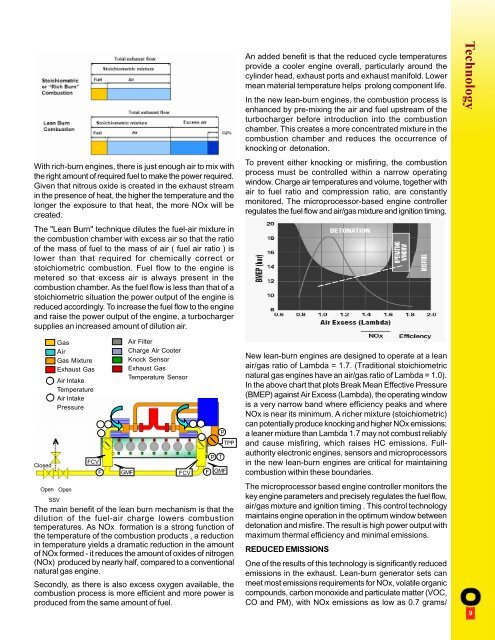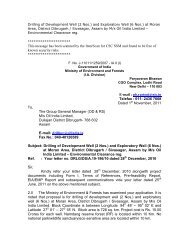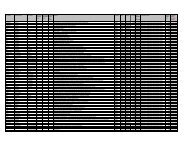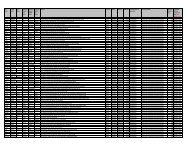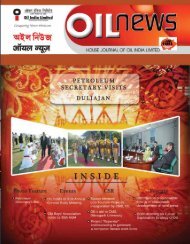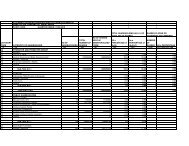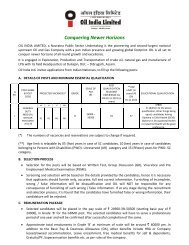Vol. 35 No. 8. May - Jun 2006 - Oil India Limited
Vol. 35 No. 8. May - Jun 2006 - Oil India Limited
Vol. 35 No. 8. May - Jun 2006 - Oil India Limited
You also want an ePaper? Increase the reach of your titles
YUMPU automatically turns print PDFs into web optimized ePapers that Google loves.
With rich-burn engines, there is just enough air to mix with<br />
the right amount of required fuel to make the power required.<br />
Given that nitrous oxide is created in the exhaust stream<br />
in the presence of heat, the higher the temperature and the<br />
longer the exposure to that heat, the more NOx will be<br />
created.<br />
The "Lean Burn" technique dilutes the fuel-air mixture in<br />
the combustion chamber with excess air so that the ratio<br />
of the mass of fuel to the mass of air ( fuel air ratio ) is<br />
lower than that required for chemically correct or<br />
stoichiometric combustion. Fuel flow to the engine is<br />
metered so that excess air is always present in the<br />
combustion chamber. As the fuel flow is less than that of a<br />
stoichiometric situation the power output of the engine is<br />
reduced accordingly. To increase the fuel flow to the engine<br />
and raise the power output of the engine, a turbocharger<br />
supplies an increased amount of dilution air.<br />
An added benefit is that the reduced cycle temperatures<br />
provide a cooler engine overall, particularly around the<br />
cylinder head, exhaust ports and exhaust manifold. Lower<br />
mean material temperature helps prolong component life.<br />
In the new lean-burn engines, the combustion process is<br />
enhanced by pre-mixing the air and fuel upstream of the<br />
turbocharger before introduction into the combustion<br />
chamber. This creates a more concentrated mixture in the<br />
combustion chamber and reduces the occurrence of<br />
knocking or detonation.<br />
To prevent either knocking or misfiring, the combustion<br />
process must be controlled within a narrow operating<br />
window. Charge air temperatures and volume, together with<br />
air to fuel ratio and compression ratio, are constantly<br />
monitored. The microprocessor-based engine controller<br />
regulates the fuel flow and air/gas mixture and ignition timing.<br />
Technology<br />
Closed<br />
Gas<br />
Air<br />
Gas Mixture<br />
Exhaust Gas<br />
Air Intake<br />
Temperature<br />
Air Intake<br />
Pressure<br />
Open Open<br />
SSV<br />
FCV<br />
F<br />
Air Filter<br />
Charge Air Cooter<br />
Knock Sensor<br />
Exhaust Gas<br />
Temperature Sensor<br />
GMF FCV F GMF<br />
The main benefit of the lean burn mechanism is that the<br />
dilution of the fuel-air charge lowers combustion<br />
temperatures. As NOx formation is a strong function of<br />
the temperature of the combustion products , a reduction<br />
in temperature yields a dramatic reduction in the amount<br />
of NOx formed - it reduces the amount of oxides of nitrogen<br />
(NOx) produced by nearly half, compared to a conventional<br />
natural gas engine.<br />
Secondly, as there is also excess oxygen available, the<br />
combustion process is more efficient and more power is<br />
produced from the same amount of fuel.<br />
P<br />
P<br />
T<br />
TPP<br />
New lean-burn engines are designed to operate at a lean<br />
air/gas ratio of Lambda = 1.7. (Traditional stoichiometric<br />
natural gas engines have an air/gas ratio of Lambda = 1.0).<br />
In the above chart that plots Break Mean Effective Pressure<br />
(BMEP) against Air Excess (Lambda), the operating window<br />
is a very narrow band where efficiency peaks and where<br />
NOx is near its minimum. A richer mixture (stoichiometric)<br />
can potentially produce knocking and higher NOx emissions;<br />
a leaner mixture than Lambda 1.7 may not combust reliably<br />
and cause misfiring, which raises HC emissions. Fullauthority<br />
electronic engines, sensors and microprocessors<br />
in the new lean-burn engines are critical for maintaining<br />
combustion within these boundaries.<br />
The microprocessor based engine controller monitors the<br />
key engine parameters and precisely regulates the fuel flow,<br />
air/gas mixture and ignition timing . This control technology<br />
maintains engine operation in the optimum window between<br />
detonation and misfire. The result is high power output with<br />
maximum thermal efficiency and minimal emissions.<br />
REDUCED EMISSIONS<br />
One of the results of this technology is significantly reduced<br />
emissions in the exhaust. Lean-burn generator sets can<br />
meet most emissions requirements for NOx, volatile organic<br />
compounds, carbon monoxide and particulate matter (VOC,<br />
CO and PM), with NOx emissions as low as 0.7 grams/<br />
9


